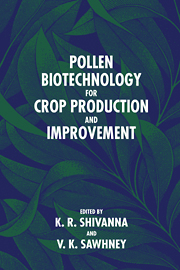Book contents
- Frontmatter
- Contents
- Contributors
- Foreword
- Preface
- 1 Pollen biology and pollen biotechnology: an introduction
- Part I Pollen biology: an overview
- Part II Pollen biotechnology and optimization of crop yield
- 5 Pollination efficiency of insects
- 6 Pollination constraints and management of pollinating insects for crop production
- Part III Pollen biotechnology and hybrid seed production
- Part IV Pollen biotechnology and plant breeding
- Index
6 - Pollination constraints and management of pollinating insects for crop production
Published online by Cambridge University Press: 11 September 2009
- Frontmatter
- Contents
- Contributors
- Foreword
- Preface
- 1 Pollen biology and pollen biotechnology: an introduction
- Part I Pollen biology: an overview
- Part II Pollen biotechnology and optimization of crop yield
- 5 Pollination efficiency of insects
- 6 Pollination constraints and management of pollinating insects for crop production
- Part III Pollen biotechnology and hybrid seed production
- Part IV Pollen biotechnology and plant breeding
- Index
Summary
Summary
Enhancing insect pollination makes a significant contribution to the value of many commercially important crops by decreasing the time to crop maturity and by increasing crop uniformity, quantity, and quality. There are still many crops, however, that suffer yield losses in situations where adequate pollinator populations cannot be maintained. Plant and pollinator components of cropping systems can be managed to enhance pollinator visitation, increase the rate and quality of pollen transfer, or both. This chapter discusses the efficiency, costs, and benefits of different management strategies that have been developed to maintain and enhance pollinator populations on crops and to increase the rate and quality of pollen transfer.
Introduction
Insect pollinators are a crucial component in the production of many commercially important crops. Enhancing the amount or quality of insect pollination can lead to increases in crop value by decreasing the time to crop maturity and by increasing crop uniformity, quantity, and quality. The diverse group of insect species that play a role in crop pollination range from those that are incidental flower visitors to those that are superbly adapted for pollinating flowers on which they forage exclusively for their food.
Each species of insect has specific morphological, physiological, behavioral, and life history constraints that affect its abundance, effectiveness, and distribution on pollinated crops. These constraints have a direct bearing on the ways in which insects can be most effectively and economically manipulated for the purpose of enhancing crop pollination.
- Type
- Chapter
- Information
- Pollen Biotechnology for Crop Production and Improvement , pp. 121 - 152Publisher: Cambridge University PressPrint publication year: 1997
- 3
- Cited by

